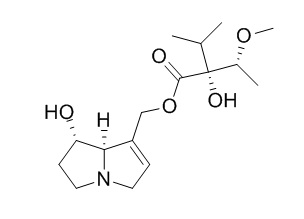Heliotrine
The pyrrolizidine alkaloid Heliotrine interferes with reporter signals derived from GAL4-based nuclear receptor transactivation assays by a mechanism independent of luciferase enzyme inhibition. Acute hepatitis induced by Heliotrine is accompanied by uncoupling of oxidative phosphorylation in liver mitochondria.
Inquire / Order:
manager@chemfaces.com
Technical Inquiries:
service@chemfaces.com
Tel:
+86-27-84237783
Fax:
+86-27-84254680
Address:
1 Building, No. 83, CheCheng Rd., Wuhan Economic and Technological Development Zone, Wuhan, Hubei 430056, PRC
Providing storage is as stated on the product vial and the vial is kept tightly sealed, the product can be stored for up to
24 months(2-8C).
Wherever possible, you should prepare and use solutions on the same day. However, if you need to make up stock solutions in advance, we recommend that you store the solution as aliquots in tightly sealed vials at -20C. Generally, these will be useable for up to two weeks. Before use, and prior to opening the vial we recommend that you allow your product to equilibrate to room temperature for at least 1 hour.
Need more advice on solubility, usage and handling? Please email to: service@chemfaces.com
The packaging of the product may have turned upside down during transportation, resulting in the natural compounds adhering to the neck or cap of the vial. take the vial out of its packaging and gently shake to let the compounds fall to the bottom of the vial. for liquid products, centrifuge at 200-500 RPM to gather the liquid at the bottom of the vial. try to avoid loss or contamination during handling.
Anesth Pain Med (Seoul).2020, 15(4):478-485.
Biomed Chromatogr.2016, 30(10):1573-81
J Med Chem.2023, 66(6):4106-4130.
J Ethnopharmacol.2020, 269:113752.
Korean Journal of Pharmacognosy2017, 48(4):320-328
Molecules.2021, 26(9):2802.
Antioxidants (Basel).2020, 9(7):581.
Int J Mol Sci.2015, 16(1):1232-51
Huazhong Agricultural University2022, pp34.
J Agric Food Chem.2024,72(37):20396-20409.
Related and Featured Products
Mol Nutr Food Res. 2014 May;58(5):995-1004.
Structure-activity relationship in the passage of different pyrrolizidine alkaloids through the gastrointestinal barrier: ABCB1 excretes heliotrine and echimidine.[Pubmed:
24375927]
1,2-Unsaturated pyrrolizidine alkaloids (PA) are found in plants such as Asteraceae and Boraginaceae families. Acute PA poisoning via contaminated food or feed causes severe damage to liver depending on species-specific oral bioavailability. For assessing PA bioavailability, their passage across the intestinal barrier was investigated using Caco-2 cells.
METHODS AND RESULTS:
Differentiated Caco-2 cells were exposed in transport chambers to the PA Heliotrine (Hn), echimidine (Em), senecionine (Sc), and senkirkine (Sk). Cell supernatants were analyzed by LC-MS/MS.
PA pass Caco-2 monolayer from the apical into basolateral compartment depending on their chemical structure. Compared to the cyclic diesters Sc and Sk with a passage rate of 47% ± 4 and 40% ± 3, respectively, the transferred amount of the monoester Hn (32% ± 3) and open-chained diester Em (13% ± 2) was substantially lower. This suggested an active transport of Hn and Em. Using Madin-Darby canine kidney II/P-glycoprotein (ABCB1)-overexpressing cells, the active excretion of Hn and Em by ABCB1 from the gastrointestinal epithelium into the gut lumen was shown.
CONCLUSIONS:
PA cross the intestinal barrier structure-dependently. The passage of the noncyclic PA Hn and Em is reduced by an ABCB1-driven efflux into the gastrointestinal lumen resulting in a decreased oral bioavailability.
Anal Biochem. 2015 Jul 23.
Utility of an appropriate reporter assay: Heliotrine interferes with GAL4/UAS-driven reporter gene systems.[Pubmed:
26212314]
Reporter gene assays are widely used for the assessment of transcription factor activation following xenobiotic exposure of cells. A critical issue with such assays is the possibility of interference of test compounds with the test system, for example, by direct inhibition of the reporter enzyme.
METHODS AND RESULTS:
Here we show that the pyrrolizidine alkaloid Heliotrine interferes with reporter signals derived from GAL4-based nuclear receptor transactivation assays by a mechanism independent of luciferase enzyme inhibition.
CONCLUSIONS:
These data highlight the necessity to conduct proper control experiments in order to avoid perturbation of reporter assays by test chemicals.
Biomed Sci. 1991;2(5):460-4.
Disturbances in oxidative phosphorylation in the liver of rats with heliotrine-induced hepatitis and restoration by phosphatidylcholine and ATP.[Pubmed:
1668644]
Acute hepatitis induced by Heliotrine is accompanied by uncoupling of oxidative phosphorylation in liver mitochondria.
METHODS AND RESULTS:
The rate of oxygen uptake during succinate oxidation increased in all metabolic states, while the respiratory control index decreased by 45% because of the greater increase in the respiration rate in state 4 by comparison with that in state 3. Heliotrine poisoning also halved the rate of oxygen uptake in rat liver homogenates in the presence of ascorbate and tetramethylene-p-phenylenediamine. This is indicative of a lowering of cytochrome oxidase activity and of energy metabolism disturbances in rat liver. Preparations of cotton phosphatidylcholine (PC), both purified and as ATP-containing complexes (PC+ATP), as well as ATP alone, reduced the metabolic disorders in liver mitochondria of rats with acute Heliotrine-induced hepatitis.
CONCLUSIONS:
The therapeutic effect of these preparations consisted in the restoration of oxidative phosphorylation coupling and of the cytochrome oxidase activity.
The effect of PC+ATP was much greater than either PC or ATP alone. In contrast, the commercial preparation, Essential, had no beneficial effect.
J Pathol. 1980 Aug;131(4):339-55.
Comparison of the toxic effects of dehydroheliotridine and heliotrine in pregnant rats and their embryos.[Pubmed:
7431152]
METHODS AND RESULTS:
Female hooded rats were injected intraperitoneally on the 14th day of pregnancy with dehydroheliotridine (DHH), a pyrrolic metabolite of pyrrolizidine alkaloids, at 30 to 90 mg/kg, or with the alkaloid Heliotrine at 200 mg/kg and the effects on the embryos were evaluated on the 20th day. DHH was both growth-retarding and teratogenic. A dose of 40 mg DHH/kg approximated 200 mg Heliotrine/kg in its effects on embryos, the principal abnormalities being skeletal, including retarded ossification, distorted ribs and long bones, cleft palate and feet defects. At higher dose rates growth almost ceased in many tissues and although more than 60 per cent. of the embryos were alive they would not have survived birth.
CONCLUSIONS:
All were very immature and had multiple skeletal and visceral defects. The effects observed in the liver were anomalous in that the embryonic parenchyma showed little response to the anti-mitotic activity of DHH.



